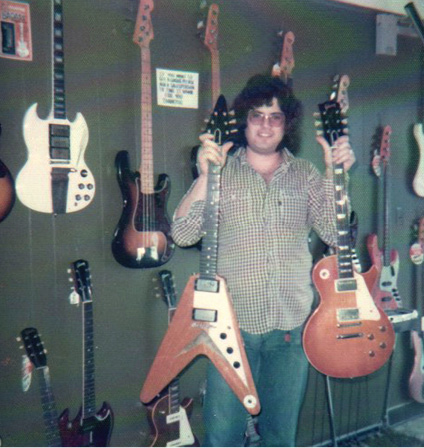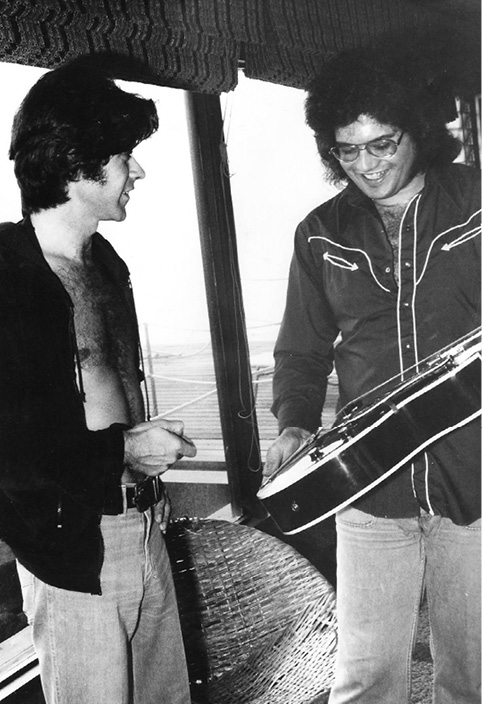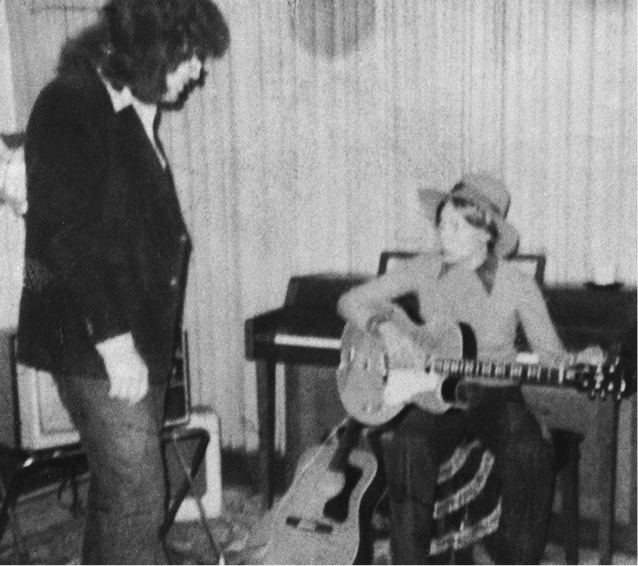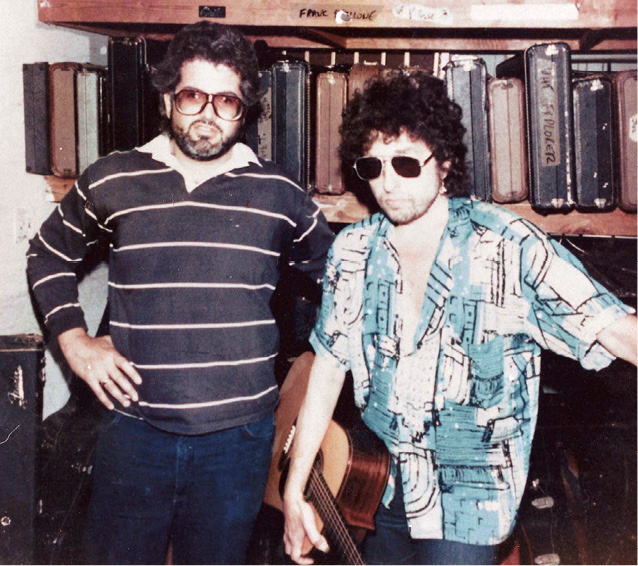7
My experience with George Harrison helped keep my own creative fires burning. I was so inspired by him, I continued to pursue my own music. Proximity to that much success surely had to count for something!
I joined a band called the Charlie Dawg Band that just happened to be named after lead guitarist Dan Walsh’s Samoyed. Dan and the rest of the band were from Sacramento. There was Ed Robles (later known as Gabriel Black) on saxophone and vocals, Fred Gerrard on second guitar, Bud Harpham on bass, Brian Clark on drums, and me on Hammond B-3 organ. Bud Harpham eventually left the band and was replaced by Ron Blair. Ron at a later date joined a little band called Tom Petty and the Heartbreakers.
By this time, I had moved to Reseda and had opened my first store, five hundred feet of raw space at 6753 Tampa Avenue. The rent was about $480 a month. I was trying to come up with nifty names for the store, like Guitar City, or Guitar Heaven, but Marlene convinced me to use my own name for the store. Everybody just knew me as Norm, so I wanted to retain my clientele. At first I was uncomfortable calling the store Norman’s Rare Guitars. Thank God I did, because the store’s name and brand have remained after all these years.

Norman’s first store at 6753 Tampa Avenue, Reseda, California. (Photo by Marlene Harris)
A friend of mine, Scott Borden, used to consign some of my instruments at the Whole Earth Market, which was kind of a seventies-style shopping arcade with a lot of hippy-era stuff for sale. People were selling small pyramids and telling folks if they put their cigarettes or anything inside the pyramid, it would improve in quality. This was a little nutty, but some people went for it. I needed Scott, because someone had to mind the store while I was out digging up old instruments. He was crucial to my operations but later staked out his own claim as an owner of two recording studios.
But selling was still Plan B for me. I was again burning candles at both ends—getting up at 6:00 a.m. to hunt down old guitars in the newspapers, opening the shop from 11:00 a.m. to 6:00 p.m., going out to play the clubs from 9:00 p.m. to 2:00 a.m., crashing, then starting all over again. I was still in my twenties, so I could handle the sleep deprivation.
Charlie Dawg got some good traction in the area. We toured up and down California. We played all the top clubs, including the Whiskey a Go Go in Hollywood, and were also the house band at the infamous Topanga Corral, which inspired Jim Morrison’s “Roadhouse Blues.”
The Corral was the hippy hub of the hippiest canyon in LA. Canned Heat did an album in the sixties called, Live at the Topanga Corral, which had actually been recorded in Hollywood. There were a slew of colorful characters who hung out there. “Jeff the Chef” once drove his Harley onto the dance floor completely naked, while tripping. “Topanga Dick” was an old beatnik who lived in this abandoned school bus behind the Corral. Often during our last set, we’d encourage Dick to come up and recite stream-of-consciousness poetry while we grinded a slow blues in the background.
We always liked to play funky dance music, and one night Dick was dancing while holding this box. He would dance, then shake the box, dance, then shake it some more. Every set he came out with this box, held it over his head, and shook it. Finally we asked him, “What’s in the box, Dick?”
“Oh, that’s Jeff. He was killed in a motorcycle accident. We’re going to spray his ashes all over the canyon. We wanted him to have a last night dancing at the Corral.”
When I look back I see how crazy it was, but we were young, and we dug it.
In spite of the antics, the Charlie Dawg Band was really solid musically, and we performed good original material. We recorded at the legendary Sound City Studios at the same time Lindsey Buckingham and Stevie Nicks were working together, pre–Fleetwood Mac. The great band War and Rick Springfield were also recording there when we were there.
After we made a name for ourselves in LA, we got a gig playing the state fair in Sacramento and also got booked into the famous Crabshaw Corners (the top club in Sacramento). It was an important homecoming gig for the guys in the band. Everybody’s friends and families were there, as well as all the names on the scene, including Craig Chaquico, the hot, young guitarist of the Jefferson Starship. So we really had something to prove that night.

Norman with Robbie Robertson at Robbie’s house in Malibu. (Photo by Marlene Harris)
Baboo Pierre, the colorful Rastafarian percussionist from the David Lindley Band (El Rayo X) was playing with us. He was a fabulous musician who always referred to himself in the third person. “Baboo hungry,” or “Baboo tired.”
After the first tune, Ed stepped up to the mike to welcome all the friends, fans, and family. He was talking and suddenly, Baboo grabbed the microphone out of his hands and started repeating over and over again, “People, do you know what I want? People, do you know what I want?” It was an uncomfortable moment, until just as suddenly, Baboo passed out and hit the deck, unconscious. We didn’t know what to do, so finally we dragged him to the back of the stage right behind the bandstand and finished the set.
Apparently, Baboo had eaten a few magic mushrooms prior to the gig and “came on” at the exact wrong moment. After the set, all the friends and family came backstage to visit, and Baboo was still rolling around, semi-unconscious and flailing. Everybody had to step over him as we all talked about how good the show was. As if it were normal . . . musicians!
Ah, the seventies . . . Put the natural craziness of musicians together with a whole bunch of drugs, and eventually it’s going to hit the rocks. Truly, the music culture back then was far different from today, where most everybody thinks and acts like a professional and is focused on moving up the ladder. We thought it would just fall into place, but mostly it just fell apart.
But even as my musical career was moving in fits and starts, my proximity to all the “hitters” in town started dictating my future. One day I received a phone call from a “Robbie,” in response to my ad in the LA Times. I gave him my address, and he came over to my apartment and was very impressed with all the instruments I had for sale.
He identified himself as Robbie Robertson from the Band. I was a big fan of the Band and still am. But at the time I didn’t know what Robertson looked like, so I had to take his word for it. That day Robbie bought a vintage Martin, as well as a Fender Stratocaster from me. He said he would tell some friends about me, because he had never seen so many great vintage instruments in one place. At my apartment, you could barely walk through the door. There were guitars, amplifiers, and basses everywhere.

Norman with Joni Mitchell at Norm’s first apartment in Sherman Oaks. (Photo by Marlene Harris)
The following week, Robbie called again and asked if he could bring a friend over. I said sure. We made an appointment, and Robbie came over with a friend—Bob Dylan. Bob purchased a beautiful three-point blond Gibson F-4 mandolin from me, as well as a stunning 1953 Fender Blackguard Telecaster.
As a side note, I had purchased the Telecaster from a guitarist who was part of a traveling combo that toured with The Three Stooges. Apparently to go with their live comedy act, they carried this band to add variety to their show.

Norman with Bob Dylan in the back of Norm’s first store. (Photo by Norman Harris)
So the next week, Robbie called again to ask if he could bring some other friends. Of course I said yes, and this time he showed up with Joni Mitchell, Robben Ford, and Tom Scott. They were recording the album, Court and Sparks, and they needed some inspiration. Joni bought a 1944 Herringbone D-28 acoustic. I had several at the time, and she played them and picked out the one she liked best. I think some of my guitars still have those weird tunings that she used. Robben Ford bought a beautiful 1959 Gibson ES-345TD Sunburst with a stop tailpiece. Tom Scott came just to hang out.
I owe a great debt to Robbie Robertson. He basically put me on the map, and by word of mouth, my business began to grow.
The following week Bob Dylan wanted to see another guitar of mine. I had opened up a storage unit at a place called Beverly Hills Moving and Storage on Haskell Avenue in the San Fernando Valley. Bob came
to my place, and we drove over to the storage unit. Bob was driving this older Cadillac with a ripped-up vinyl top. It was anything but classic, and more like a beater.
Bob had brought along his giant bullmastiff named Baby. So, we were in the front seat, and Baby was in the back drooling on both of us. I remember we pulled up to a red light, and a young couple pulled up next to us. They looked at us then their eyes grew wide as they saw it was Bob Dylan driving. Then they gave the raggedy Cadillac and the dog a once-over and shook their heads, deciding “nah, it can’t be Dylan.”
Meanwhile Ed Robles was also meeting me at my storage unit. We needed to get our Acoustic 360 bass amp out of storage for our next gig. Bob was standing by his Cadillac when Ed pulled up in his old Ford truck, and we needed to load the Acoustic 360 in the back. These were big and heavy amps. Bob was at the bottom of the loading dock, and I was above trying to lower the amp. Bob looked on and I said, half jokingly, “So what are you waiting for?”
Bob helped us load the amp into the truck. I really think he liked the fact that we treated him like a regular guy. So many people are in awe of Bob and don’t know how to act around him.